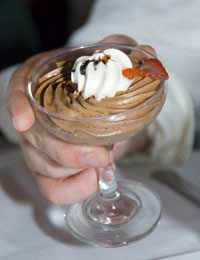E400 - E499 Thickeners, Stabilisers and Emulsifiers

E numbers that are labelled with a prefix of between E400 and E499 fall into the category of thickeners, stabilisers and emulsifiers (some are also gelling agents too). Here we offer a complete rundown of what each of these different forms of additives are and why they’re used in food, and offer insight into what each individual additive in the category is.
Thickeners do pretty much what the name suggests – they add thickness to products, bulking them up and improving the texture and look of products. Emulsifiers are added to foods to help mix together ingredients that would otherwise normally separate. One example is oil and water, which wouldn’t usually mix together sufficiently and examples of products with emulsifiers in include ice cream and mayonnaise. Stabilisers come into play by ensuring that the ingredients held together by emulsifiers won’t separate again.
There are also a couple of gelling agents included in the E400 to E499 category, mainly where they also have another role, such as being a stabiliser or emulsifier. Gelling agents play a similar role as thickeners, as they basically help foods gel together better. One example is E406, Agar. This comes from a natural source – seaweed – and is used both as a thickener, gelling agent and a stabiliser.
This category of E numbers isn’t the only to have additives with dual purposes, as many of the numbers in other categories play more than one role too. As with other E numbers, they come from both natural and synthetic, or manmade, sources.
Guide to Thickeners, Stabilisers and Emulsifiers
The following offers a complete reference guide to all the thickeners, stabilisers and emulsifiers which make up the E400 to E499 category. If you’re keen to avoid buying products with these E numbers in, or are keen to keep track of what ingredients are in certain products you’re considering purchasing, then why not print out this list and take it with you when you go shopping.- E400 – Alginic acid
- E401 – Sodium alginate
- E402 – Potassium alginate
- E403 – Ammonium alginate
- E404 – Calcium alginate
- E405 – Propane-1, 2-diol alginate
- E406 - Agar
- E407 - Carrageenan
- E408 - Furcelleran
- E410 – Locust bean gum
- E411 – Oat gum
- E412 – Guar gum
- E413 - Tragacanth
- E414 – Gum arabic
- E415 – Xanthan gum
- E416 – Karaya gum
- E417 – Tara gum
- E418 – Gellan gum
- E420 - Sorbitol
- E421 - Mannitol
- E422 - Glycerol
- E430 - Polyoxyethylene(8) stearate
- E431 - Polyoxyethylene (40) stearate
- E432 - Polyoxyethylene-20-sorbitan monolaurate
- E433 - Polyoxyethylene-20-sorbitan mono-oleate
- E434 - Polyoxyethylene-20-sorbitan monopalmitate
- E435 - Polyoxyethylene-20-sorbitan monostearate
- E436 - Polyoxyethylene-20-sorbitan tristearate
- E440 - Pectin
- E442 - Ammonium phosphatides
- E450 - Di- and polyphosphates
- E451 - Triphosphates
- E452 - Polyphosphates
- E460 - Cellulose
- E461 – Methyl cellulose
- E462 – Ethyl cellulose
- E463 - Hydroxypropyl cellulose
- E464 - Hydroxypropylmethyl cellulose
- E465 - Methylethyl cellulose
- E466 - Carboxymethyl cellulose
- E470 – Fatty acid salts
- E471 - Mono- and di-glycerides of fatty acids
- E472 - Esters of mono- and diglycerides
- E473 - Sugar esters of fatty acids
- E474 - Sugarglycerides
- E475 - Polyglycerol esters of fatty acids
- E476 - Polyglycerol polyricinoleate
- E477 - Propyleneglycol esters of fatty acids
- E478 - Mixture of glycerol and propyleneglycol esters of lactic acid and fatty acids
- E479 - Esterified soy oil
- E480 - Dioctyl sodium sulphosuccinate
- E481 - Sodium stearoyl lactate
- E482 - Calcium stearoyl lactate
- E483 - Stearyl tartrate
- E484 - Stearyl citrate
- E490 - Propylene glycol
- E491 - Sorbitane mono stearate
- E492 - Sorbitane tri stearate
- E493 - Sorbitane mono laurate
- E494 - Sorbitane mono oleate
- E495 - Sorbitane mono palmitate
- Complete List of ENumbers
- Additives in Cigarettes
- Food Additives That Act as Xenoestrogens
- Children's Sweets and E Numbers
- Blue Smarties Return without E Numbers
- E900 - E999 Miscellaneous E Numbers
- E600 - E699 Flavour Enhancers
- E1000 - E1999 Additional Chemicals
- E300 - E399 Antioxidants and Acidity Regulators
- E200 - E299 Preservatives
- E500 - E599 Acidity Regulators and Anti-Caking Agents
- E100 - E199 Colours


Re: Dangers and Side Effects of E Numbers
Is this the tip of the iceberg? Can't help thinking we all being slowly poisoned by convenience food. Convenient for…
Re: E200 - E299 Preservatives
Hallo I need advise on what preservetives and ant foaming agents to use for lemon juice. Also reconmondations on how much powders to…
Re: Top E Numbers to Avoid
Since Brexit, I have been adding a few extra E numbers in my products and my sales have boomed! I now sell the tastiest burger in town. E…
Re: E Numbers Not Suitable for a Halal Diet
Is E202 is halal?
Re: Does E631 Use Extracted Pig's Fat or Sardine Oil?
400
Re: E Numbers Not Suitable for a Halal Diet
E140 is a plant product, not derived from meat at all. Please check your facts.
Re: Top E Numbers to Avoid
I was prescribed amitriptyline for anxiety and got on well with the first box of tablets. After starting the second box I began to feel…
Re: E400 - E499 Thickeners, Stabilisers and Emulsifiers
All thickener agent name All emulsifier agents name Cemical use Food use
Re: Top E Numbers to Avoid
You say that E133 is banned in Germany, yet my GP has prescribed Fultium-D/Colecalciferol 800 out capsules with E133 and the Manufacturer…
Re: Does E631 Use Extracted Pig's Fat or Sardine Oil?
In India, there is a law already existing, that any food products having any non-vegetarian ingredients…